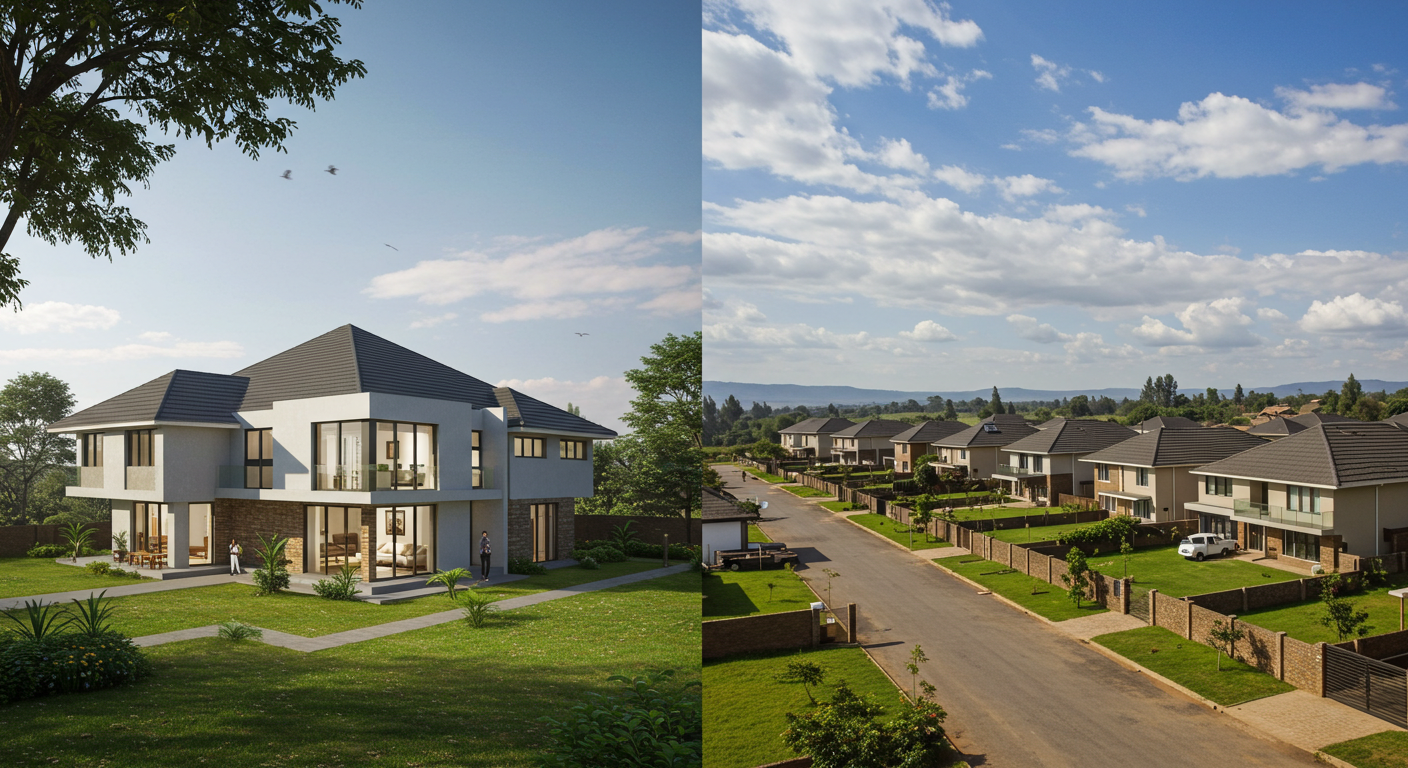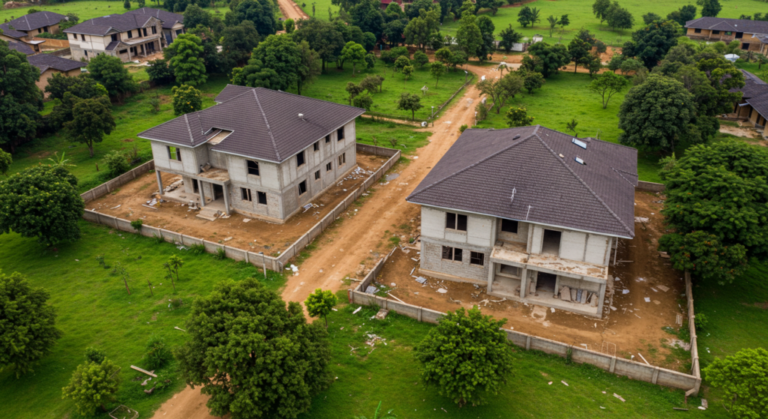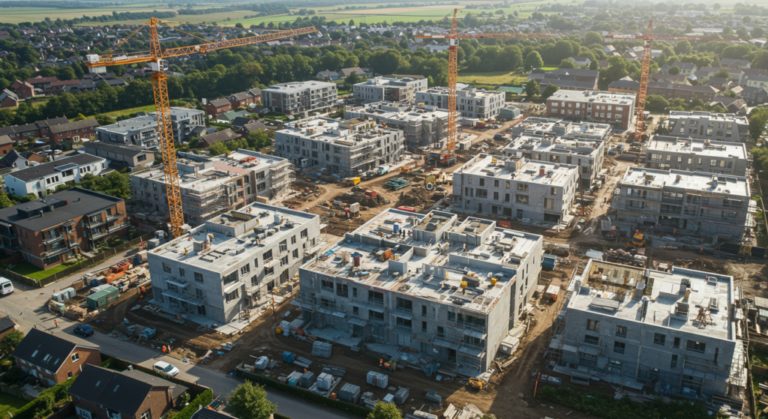Gated Communities vs. Standalone Homes: Pros and Cons in Kenya
- The real estate market in Kenya has positively progressed over the years, giving rise to a variety of residential developments.
- The concept of gated communities in Kenya began gaining traction in the early 2000s.
- Before the rise of structured estates and gated communities, building your own home on your own piece of land was the standard path to homeownership.
- Homeownership is deeply personal. Whether behind a gate or on a private plot, the true goal is a space that gives you comfort, stability, and the freedom to thrive.
The real estate market in Kenya has positively progressed over the years, giving rise to a variety of residential developments. From gated communities and apartments to mixed-use spaces and standalone homes, the options today are broad and diverse. Each of these serves different demographics and caters to the unique needs of individuals and families at different life stages.
Today, we’re zooming in on two popular options: gated communities and standalone homes. What are their pros and cons? Let’s get into it.
The Rise of Gated Communities in Kenya
The concept of gated communities in Kenya began gaining traction in the early 2000s. Before then, especially in the 1970s and 1980s, areas like Karen, Runda, and Lavington were largely inhabited by colonial settlers and later, affluent Kenyans. These neighbourhoods were spacious, orderly, and exclusive, offering a level of privacy and prestige that loosely resembled today’s gated communities. However, they were not necessarily planned developments with central management, perimeter walls, or controlled access, which are now considered standard features.
As urbanisation accelerated and security concerns increased, especially in Nairobi and its environs, more Kenyans began seeking secure, community-oriented residential options. Developers responded by creating modern gated estates, particularly in satellite towns like Syokimau, Kitengela, Ruiru, Juja, and Ngong. These areas offered more affordable land and easier access to Nairobi, thanks to major infrastructure upgrades like the Thika Superhighway and the Southern Bypass.
By the 2010s, gated communities had become a mainstream housing solution, not just in Nairobi but also in growing urban centres such as Nakuru, Kisumu, and Mombasa. Today, these developments are marketed as lifestyle hubs, often featuring schools, gyms, shops, green spaces, and private security, appealing to Kenya’s growing middle class and diaspora investors alike.
Pros of Gated Communities
1. Enhanced Security
Security is one of the biggest draws. With perimeter walls, controlled access, guards, and sometimes CCTV surveillance, gated estates offer peace of mind, especially for those with young families or demanding work schedules.
2. Shared Amenities
Many estates offer more than just homes. You’ll often find boreholes, playgrounds, jogging tracks, clubhouses, and sometimes even schools and mini-marts within the compound.
In a gated estate, you’re part of a living, breathing neighbourhood. Children have safe play areas, and residents often connect through estate events or WhatsApp groups.
4. Low Maintenance (for you personally)
Shared costs mean shared responsibilities. Roads, landscaping, and waste collection are typically managed by the estate, relieving homeowners of day-to-day upkeep.
Cons of Gated Communities
1. Limited Freedom
Many gated communities come with strict regulations, primarily to maintain a sense of uniformity and aesthetic appeal. This means making changes to your home’s exterior, like repainting, adding an extension, or installing a unique gate, is often not allowed. Some estates even go as far as restricting things like keeping livestock or hanging clothes on balconies. While these rules help preserve a clean and cohesive look, they can limit your ability to personalise your space.
2. Service Charges
When most people buy or build standalone homes, they do so knowing that their main costs will revolve around personal maintenance, things like servicing the lawn, handling repairs, or cleaning the compound. These are usually manageable, especially since you can take care of them yourself or outsource at your own pace. In gated communities, however, monthly or annual maintenance charges are standard. These fees go toward shared services like security, landscaping, garbage collection, and infrastructure upkeep. While they add convenience, they can become a financial strain if not planned for in advance.
3. Smaller Plot Sizes
Because land is divided among many homes, individual plots are often compact. If you’re dreaming of a kitchen garden or expansive backyard, space may be a compromise.
Standalone Homes: Space, Privacy, and Freedom
Standalone homes have long been a part of Kenya’s residential culture , especially in the countryside and older suburbs. Before the rise of structured estates and gated communities, building your own home on your own piece of land was the standard path to homeownership. Whether in upcountry plots, peri-urban areas, or classic Nairobi neighbourhoods like Lang’ata, South B, Buru Buru, or Komarock, standalone homes were (and still are) a popular choice for many Kenyans.
One of the biggest appeals of a standalone home is freedom. Homeowners have full control over how they build, modify, or expand their space. There’s no estate manager to approve design changes, no monthly service fees to budget for, and no restrictions on things like keeping pets, raising poultry, or planting a full kitchen garden.
In recent years, standalone homes have continued to thrive in more affordable, fast-growing towns like Kiserian, Joska, Ruai, and Kamulu, where land is still accessible and relatively cheaper. This has allowed families and investors to build spacious homes with ample compounds, often tailored to future growth, be it rental extensions, Airbnb units, or even small-scale farming.
Pros of Standalone Homes
1. Freedom to Personalise
When you own a standalone home, you’re in full control. From architectural design and roofing styles to compound layout and landscaping, you can bring your vision to life without needing approval from an estate management team. Want to build a greenhouse? Add a detached guest wing? Put up a chicken coop or install solar panels? The freedom to tailor your space to suit your lifestyle is a major plus, especially for creative homeowners or those planning long-term family growth.
2. Larger Land Size
Standalone homes often sit on more generous plots of land compared to homes in gated communities. This means more room for expansion, gardening, outdoor play areas, or even generating passive income by adding rental units. For families that enjoy space or want to build gradually, the flexibility that comes with a larger compound is both practical and empowering.
3. No Monthly Fees
One of the key advantages of living in a standalone home is the absence of monthly or annual service charges. You’re not contributing to the upkeep of shared amenities or paying estate management fees. Instead, you manage your home on your own terms, hiring services as needed and budgeting based on your priorities. For some, this autonomy is a huge financial relief.
Cons of Standalone Homes
1. You Handle Security
With independence comes responsibility and security is a big one. In a standalone setup, you’re fully in charge of your own safety. This could mean installing electric fencing, CCTV, security lights, or even hiring a private guard. These measures can be expensive to set up and maintain, and you have to stay vigilant, especially if your home is in a less-developed area.
2. Maintenance is Your Responsibility
Standalone homes require hands-on management. From organising garbage collection and maintaining your compound to sourcing water and dealing with drainage, it all falls on your shoulders. If your home is in a newly developed area, you might even need to chip in for community road repairs or power connectivity, things that would otherwise be handled by an estate management company.
3. Isolation Can Be Real
Depending on location, living in a standalone home can sometimes feel isolating, particularly if you’re far from social amenities like supermarkets, hospitals, or schools. You might also have fewer interactions with neighbours, which can be a downside if you value community. For people used to the buzz of estate life or urban convenience, this quiet lifestyle can take some adjusting.
Which One Is Right for You?
The choice between a gated community and a standalone home often comes down to your lifestyle, priorities, and financial plan.
- Are you a young family looking for a safe, social environment for your kids to grow up in?
- Are you an investor looking for long-term flexibility and land value appreciation?
- Do you travel often and need a low-maintenance lock-and-leave home, or do you enjoy home projects and garden space?
There’s no wrong choice, only the right fit for your current season.
Conclusion
Homeownership is deeply personal. Whether behind a gate or on a private plot, the true goal is a space that gives you comfort, stability, and the freedom to thrive.
So take your time, ask questions, walk the grounds, talk to residents and most importantly, listen to your gut. Your home is more than an address. It’s your sanctuary.








